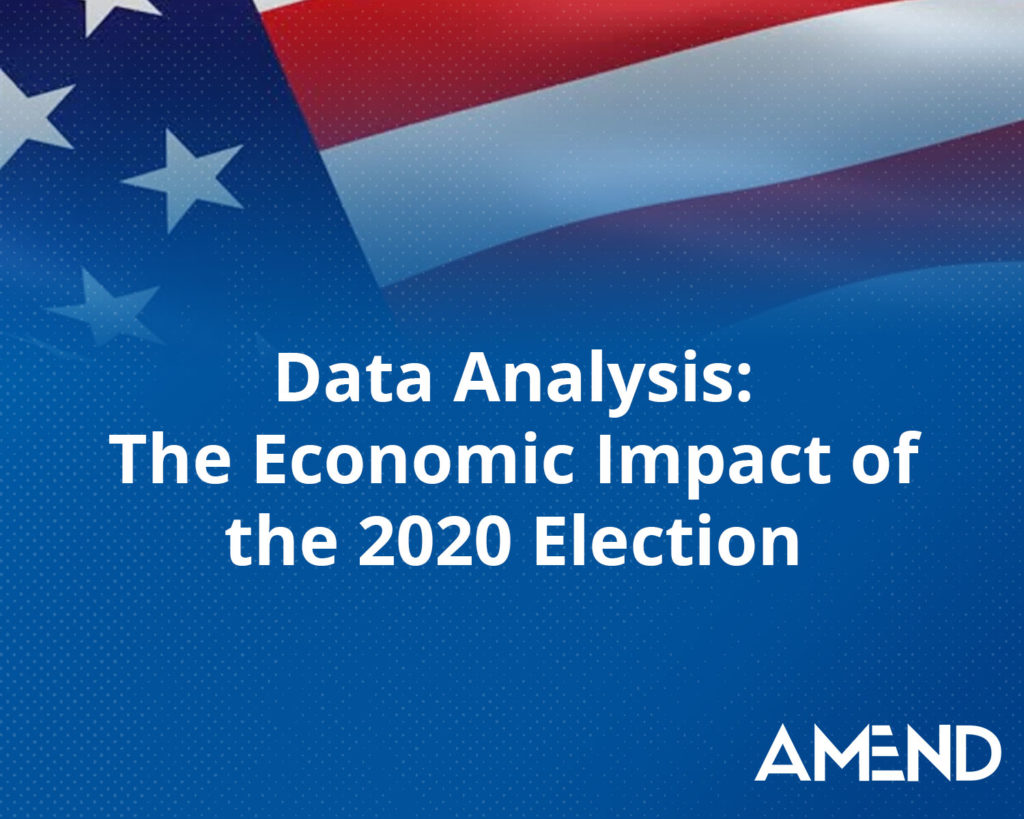
After months of building up to this moment, the big day is almost here: on Tuesday, November 3rd, the United States will be voting to determine our next president (as well as a myriad of other publicly held positions and on other key issues). Our team at AMEND Consulting figured we would take this as yet another opportunity to do what we love: diving deep into data (and we built an interactive Microsoft Power BI tool that you can access below if you want to do the same).
To assess the impact this election will have on the U.S. Economy, we looked at a handful of key economic indicators (unemployment rates, interest rates, GDP per Capita, and aspects of the stock market). By analyzing 70+ years of historical data, here are some of the insights we have identified to help understand what we should expect in the economy over the next year.
Reports may take a moment to load. For best viewing, tap the arrow in the bottom right corner of the report to open in full-screen mode. On mobile, view in landscape mode. To toggle between tabs, tap the > arrow at the bottom of the report screen or tap “1 of 7.”
Top Insights
While we get nerdy with the details and analysis below, the key insights we uncovered and found interesting through our analysis are:
1. GDP typically trends higher during election years – data indicates this can be attributed to implemented policies that give a boost to the economy. GDP the year after an election is heavily impacted by political party.
2. Elections have an insignificant impact on the national unemployment rate, though Republican presidents have historically seen lower rates during their terms.
3. Who the President is, whether the incumbent is retained and which party is elected into office largely have no impact on the stock market. However, the months just before and after an election have extensive volatility in the stock market – largely due to the uncertainty that an election brings the country. Simply that there is a Presidential election causes volatility every four years.
GDP Per Capita Annual Growth
Description: Gross Domestic Product (referred to as GDP throughout this article) has long been considered one of the best indicators for a nation’s economic health. GDP is the monetary value of all finished goods and services made within a country during a specific period. There are nuances in the calculation, but for the purpose of this article, know it is regularly used to provide an economic snapshot of a country. GDP Per Capita helps normalize the GDP metric by dividing it by the population of the nation. GDP Per Capita Growth Rates are calculated by looking at the year-over-year variances in GDP Per Capita.
AMEND Methodology: AMEND analyzed over 50 years of historical data of annual GDP Per Capita in the United States. We isolated various time periods (election years, years after an election, months preceding an election, months following an election, etc.) to identify the impact of an election on the annual growth rates of GDP Per Capita. In addition, we looked to see the impact of political party.
Insights: Year over year GDP Per Capita Growth Rates are significantly higher in years containing a general election versus all the years in our dataset (5.98% vs 5.39%). In years immediately following a general election, we see less of an impact (5.44% vs 5.39%). Of the top ten years since 1961 in GDP Per Capita Growth Rate, four took place in election years, and 3 took place in the years following the election.
If we only look at years after 1980 to remove the stretch of abnormal economic growth in the late 1970’s, five of the top 10 years took place in election years, and four took place in the years immediately following a general election. In this smaller sample size, election years continue to outperform the norm (5.08% vs 4.42%).
Comparing years with a Republican as president versus a Democrat as president, GDP Per Capita Annual Growth is consistently higher with a Republican in office (5.72% vs 5.00%). In the years immediately following an election, Republicans see a large increase (6.67%) compared to Democrats (4.02%).
Verdict: The year of an election is associated with higher GDP Per Capita Growth Rates, which can largely be attributed to policies being implemented that give a boost to the economy immediately before an election. Across our entire dataset, there is no significant variance in GDP Per Capita Growth Rates in years following an election. However, in the year following an election, the data does show that Republican presidents tend to see more growth in the first of the year of their term than Democratic presidents (even after removing 2009 – the only year in the last fifty that saw a negative annual GDP Per Capita Growth Rate due to The Great Recession).
Unemployment Rates
Description: The unemployment rate is the percentage of unemployed workers in the labor force. Despite being a lagging indicator (i.e. it does not anticipate changes in the economy but is a direct result of changes in the economy), it is often used to measure economic health.
AMEND Methodology: AMEND analyzed over 35 years of historical data of monthly unemployment numbers in the United States. We isolated various time periods (election years, years after an election, months preceding an election, months following an election, etc.) to identify the impact of an election on unemployment. In addition, we looked to see the impact of political party.
Insights: It is very difficult to attribute the impact of an election on the unemployment rate. Since 1984, there is a small increase in the unemployment rate in election years versus non-election years (6.02% vs 5.91%), but not enough to suggest statistical significance. Unemployment rates in the months preceding an election versus the months following an election are quite similar (variances within 0.1%). Four of the top ten years of unemployment were the years following an election and three were in election years.
Republican presidents have shown lower unemployment rates during their terms compared to Democrats (5.63% vs 6.33%) and tend to see lower unemployment in their first year following an election compared to Democrats (5.50% vs 6.87%). However, much of this variance can be attributed to the high unemployment rates in 2009 caused by The Great Recession.
Verdict: We should not expect to see large impacts in the unemployment rate immediately after the upcoming election. Again, the unemployment rate is considered a lagging indicator in that changes in the unemployment rate follow other shifts in the economy.
Stock Market Gains/Volume
Description: The S&P 500 is a stock market index that is comprised of 500 large-cap stocks in the United States. The index is often used as a barometer for the stock market in general. Trading volume shows the number of shares that were traded over a time period. Often, trading volume is calculated as an average per day.
AMEND Methodology: AMEND analyzed over 30 years of daily trading data for the S&P 500 index. We isolated various time periods (election years, years after an election, months preceding an election, months following an election, etc.) to identify the impact of an election on the volume of trading and gains/losses of the S&P 500 index. Furthermore, we created forward-looking predictive models based on historical data to see if we could predict stock prices with high accuracy.
Insights: The data clearly shows there are far greater gains in the months following an election compared to the months preceding an election. On average, the 6 months after an election leads to a 4.69% gain in the S&P 500 Index, whereas the 6 months preceding an election has an average loss of 2.67%. While some of this can be attributed to the economic downturn in 2008, the uncertainty of elections also will lead to smaller gains in the stock market in the months preceding the election. Only once in the past 20 years (2012) has the volume of trades been lower in an election year than the year prior. Findings from our predictive models showed that the election does not have a statistically significant impact on returns.
Verdict: The months preceding an election are associated with high volume of trading on the stock market but smaller gains compared to the norm. After an election, the S&P 500 has had much larger gains as the uncertainty of the election is resolved. Controlling for other variables, investors in the stock market should be hopeful for positive returns in the months to come.
Stock Market Volatility
Description: Stock market volatility is used to show the distribution of stock prices; high volatility means stock prices have a greater distribution with higher maximum values and lower minimum values. Stock market volatility is determined by calculating the standard deviation of stock price daily gains/losses within a time period. The standard deviation is then converted to an annualized volatility metric. Larger values mean more volatility, lower values mean less volatility.
AMEND Methodology: AMEND analyzed over 30 years of daily trading data for the S&P 500 index. We isolated various time periods (election years, years after an election, months preceding an election, months following an election, etc.) to identify the impact of an election on stock market volatility. In addition, we looked to see the impact of political party.
Insights: Volatility tends to be higher in election years than non-election years (0.19 vs 0.17). More interesting is that we tend to see much higher volatility in the months preceding an election and the months following election. The volatility three months before an election and after an election are far higher than the average (0.23 and 0.22 vs 0.18); even more pronounced is that the volatility three months before an election is greater than the volatility 6 months before an election, and the volatility 6 months before an election is greater than the volatility 12 months before an election. This pattern holds true for the months following an election. This holds true across party lines.
Verdict: The data clearly shows us that months after the election will most likely be a time of extensive volatility in the stock market. For risk-seeking investors, there is great opportunity to capitalize on a volatile market. For passive investors, you should expect large fluctuations immediately after the election that diminish as time goes on.
Predictive Models
Stock Market Gains/Volume Model Description: As the one-year mark allows for the market to settle out, we’ll dive into a model used to predict the percentage change from the yearly open to the yearly close. Variables tested in the models include combinations of the following: a flag for post-election year, an incumbent/new president flag, presidential party, Senate majority, House majority, pervious year percentage change, and combinations of the parties of the president, Senate, and House.
Insights: Some of the best models ended up with an Adjusted R-square values around 0.12, meaning that only 12% of the variance in the Stock Market’s Year over Year Percentage Change can be explained by these variables. This leaves a lot of variance unaccounted for – this could be from a number of economic factors. Regardless of the explanation of the remaining variance, it is safe to say that election results do not explain much of the change in early S&P returns. In addition to the low Adjusted R-squared values, the p-values of most variables in this model range from 0.11 – 0.25, meaning that there is strong evidence that these variables are not affecting the index’s change – whether it be positive or negative. With respect to accuracy or impact of variables included, AMEND would not consider a model that looks solely at Presidential elections, political parties and changes to critical offices to be predictive of annual stock market changes.
Deeper analysis into the parties of President, Senate Majority, and House Majority showed similar results. Over the past 70 years the most common combination of President Party, Senate Majority, and House Majority has been Republican, Democrat, Democrat, respectively. During these years, the average increase is 4.8% while the combination of Democrat, Democrat, Democrat has seen an average increase of 9.8%. Although these numbers seem to indicate higher returns during years with Democratic leadership, there is not a statistically significant relationship between average return percentage change and the parties of the leadership.
Verdict: The models overwhelmingly indicated that changes in the S&P 500 cannot be directly linked to the outcome of the presidential election – regardless of the winners’ party
Unemployment Rate Model Description: Next, AMEND wanted to see the impact that a new president has on the unemployment rate. Using unemployment data starting in 1950, we bucketed monthly unemployment rates into quarters to look at the average rates in each period. Initial analysis indicates that unemployment rates have been highest in years with a newly elected Democratic president.
Insights: Using two variables, the Presidential Party and a flag for a newly elected president, we aimed to predict the Q4 national unemployment rate. The resulting model did not capture a great deal of the variation in unemployment rates; however, the model does indicate that there is a relationship between the variables and the output. The model echoes the initial analysis – a newly elected Democratic president sees the highest predicted increase in fourth quarter unemployment percentage. Interestingly, the lowest increase in unemployment rates comes in years with a Democratic president that has been in office for at least one year.
Verdict: Although, there is a relationship between the presidential party, years in office, and the unemployment rate, there is still a lot of the rate that is explained by external factors.
Summary
The state of the economy over the next year will be greatly impacted by the winner of the election, the economic policies of the winner, and potentially infinite variables that could take place in the world (natural disasters, war, etc.). While we can’t predict with certainty what the months following the 2020 election will bring, the historical data of previous elections tells us a few things we could see: small unemployment changes and high volatility in the stock market, with potential slight net increase as the market stabilizes.
Are you curious as to how a specific set of uncertainties or different “realities” may impact your business? Our team develops solutions to fit your performance-driving KPIs and support your short and long-term strategy planning. Fill out the form below if you’re interested in partnering with AMEND to better understand the What, Why and So What of your organization’s data.
Authors

Gabe Welp is a Project Leader at AMEND Consulting. Gabe specializes in developing and deploying business intelligence solutions at organizations in the Cincinnati area. Gabe teaches the Introduction to Power BI and Advanced Power BI courses provided by the University of Cincinnati Center for Business Analytics. Outside of work, Gabe loves running, hanging out with his 6-month old kitten, and spending obscene amounts of time on Twitter.

Joe Ratterman is a Project Leader focusing on technical solutions for clients. His skills and interests include process automation, data wrangling, and predictive modeling. Using these skills, he is able to build custom, sustainable tools to drive growth and efficiency gains for clients from a variety of industries.









